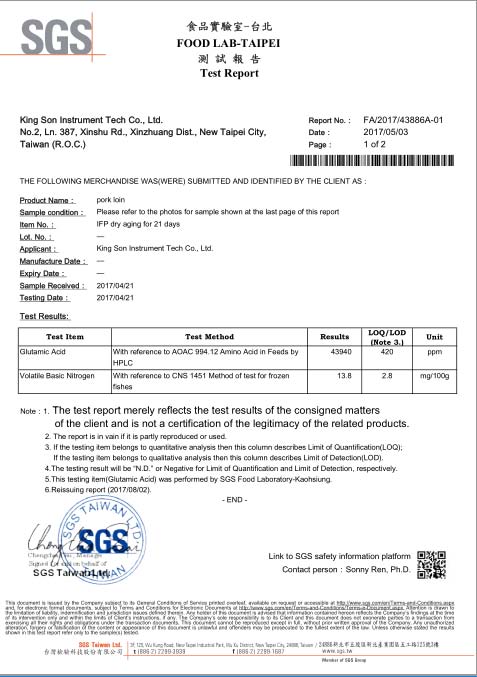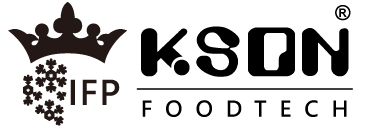King Son Dry aging pork experiment
Case Study: Dry aging pork above Initial Freezing Point
In this study, we use weight change, pH value, shear force value, VBN value, glutamic acid content and flavor change as indicators to assess changes in the aging quality of the pork loin through the process of dry aging.
Dry aging conitions and parameters
-
Temperature: -1.0℃, above initial freezing point -1.7℃
-
Humidity: 80%RH
-
Aging time: 35 days
The pork loin achieved a stable state in the required 21 days needed for dry aging.
Appearance and weight change
-
dry aging process above IFP on day 0
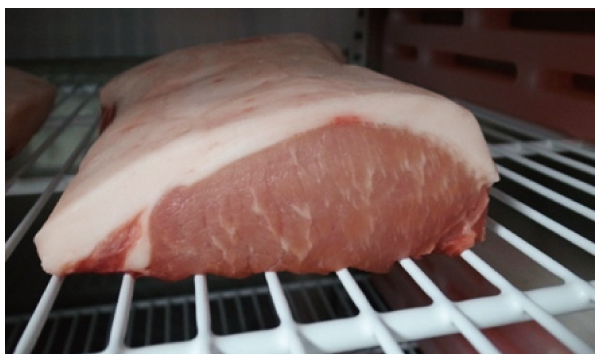
-
dry aging process above IFP on day 28

pH value change
- pH value between 5.8-6.2 is defined as fresh meat, between 6.3-6.6 is defined to sub-fresh meat, and pH above 6.7 is spoiled meat.
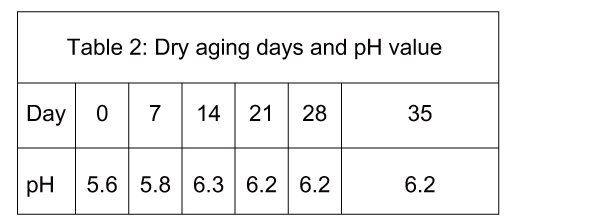
- Throughout the entire 35 days IFP dry aging process, the quality of pork loin is mostly preserved in the fresh meat.
Measurement of Volatile basic ni-trogen
-
Volatile basic nitrogen (VBN) is a general term referring to the presence of amines and ammonia within the food’s tissue and composition as produced by the activities of microorganisms and enzymes.
-
In general, if the VBN value ≦ 15mg/100g is a fresh meat, VBN value between 15 to 25 mg/100g is belonged to sub-fresh meat, if the VBN value is greater than 25mg/100g is a spoiled meat.
-
The VBN value was 13.8mg/100g on the day 21 during dry aging process and the VBN value on day 35 was 17.9mg/100g which are all far below the VBN number indicating spoiled meat (25mg/100g).
From the results of pH and VBN measurements, we can confirm that IFP dry aging process is safe for foods, which can be attributed to the stable IFP dry aging process environment provided by King Son Convertible IFP Aging Chiller.
Penetration force measurement
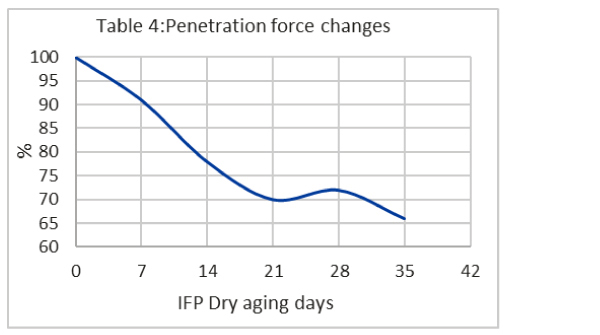
- IFP dry aging process produce tenderness effects on meat, with time evolution the effect of tenderness is continuously present and penetration force declines within two weeks, in which the penetration force on day 21 and day 35 drops about 30%. This indicates the meat tenderness has undergone significant changes.
Glutamine acid and aroma devel-opment
- In the process of aging, the protein molecules in the meat will break down into smaller amino acid fragments, including amino acid species which are associated with perceived savoury and delicious-ness. One such amino acid is Glutamic acid, which is the amino acid associated with the savoury umami flavor, is present in the form of monosodium glutamate which in turn is the main compo-nent of sodium glutamate. Therefore,we selected glutamate as a monitoring indicator to observe the changes of glutamic acid contents during IFP dry aging process.
- We found that the glutamic acid content increase significantly during IFP dry aging process that varies by different sample taken locations. The glutamic acid con-tents increase between 13% and 28%, maximum up to 43940ppm, this result provides a scientific evidence that IFP dry aging process can in-crease the delicious taste and umami flavor of meat.
- One more distinguishing characteristic of the IFP dry aging process is that it can induce the develop-ment unique aromas within the food that is not otherwise present in the food before. In this experiment, after 21 days the pork loin began to develop special aromas familiar to milk and cheese. This result is positively striking, as the development of this aroma can only be enabled through IFP dry aging; according to our observations, the aroma development at first was produced from the fat and slowly to the lean muscle parts of the meat, therefore, we can reasonably speculate that the aroma source is the aromatic fatty acid produced by the decomposition of fat after aging.
To summarize on the above experimental results, during IFP dry aging process, the weight loss of pork loin tends to be stabilize after about two weeks, the penetration force value tends to stabilize after about three weeks and begins to produce the unique aromas after the third week. The pH value 6.2 and VBN values 17.9mg/100g of pork lion on day 35 during IFP dry aging are still within safe range and met with quality food standards. In all, these results demonstrate that there is a viable poten-tial business model around the dry aging of pork loin using the King Son Convertible IFP Aging Chiller. Pork loins are matured and ready on day 21 for sale or cooking, and can be also preserved in the same chamber for further aging and extends shelf life for another 2 weeks, until completely aging on day 35. In this experiment, King Son Convertible IFP Aging Chiller provides constant temperature and humidity and UVC Air Ventilation Bacteriostatic System, thus playing the most important role in ensuring the quality safety of the meat during IFP dry aging process.
